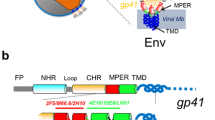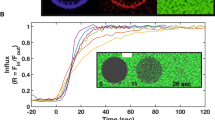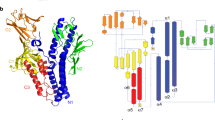Abstract
The entry of enveloped animal viruses into their host cells always depends on membrane fusion triggered by conformational changes in viral envelope glycoproteins. Vesicular stomatitis virus (VSV) infection is mediated by virus spike glycoprotein G, which induces membrane fusion between the viral envelope and the endosomal membrane at the acidic environment of this compartment. In this work, we evaluated VSV interactions with membranes of different phospholipid compositions, at neutral and acidic pH, using atomic force microscopy (AFM) operating in the force spectroscopy mode, isothermal calorimetry (ITC) and molecular dynamics simulation. We found that the binding forces differed dramatically depending on the membrane phospholipid composition, revealing a high specificity of G protein binding to membranes containing phosphatidylserine (PS). In a previous work, we showed that the sequence corresponding amino acid 164 of VSV G protein was as efficient as the virus in catalyzing membrane fusion at pH 6.0. Here, we used this sequence to explore VSV–PS interaction using ITC. We found that peptide binding to membranes was exothermic, suggesting the participation of electrostatic interactions. Peptide–membrane interaction at pH 7.5 was shown to be specific to PS and dependent on the presence of His residues in the fusion peptide. The application of the simplified continuum Gouy–Chapman theory to our system predicted a pH of 5.0 at membrane surface, suggesting that the His residues should be protonated when located close to the membrane. Molecular dynamics simulations suggested that the peptide interacts with the lipid bilayer through its N-terminal residues, especially Val145 and His148.







Similar content being viewed by others
References
Berendsen HJC, Postma JPM, Dinola A, Haak JR (1984) Molecular dynamics with coupling to an external bath. J Chem Phys 81:3684–3690
Berendsen HJC, Grigera JR, Straatsma TP (1987) The missing term in effective pair potentials. J Phys Chem 91:6269–6271
Boström M, Williams DRM, Ninham BW (2004) Specific ion effects: Role of salt and buffer in protonation of cytochrome c. Eur Phys J 13:239–245
Carneiro FA, Ferradosa AS, Da Poian AT (2001) Low pH-induced conformational changes in vesicular stomatitis virus glycoprotein involve dramatic structure reorganization. J Biol Chem 276:62–67
Carneiro FA, Bianconi ML, Weissmuller G, Stauffer F, Da Poian AT (2002) Membrane recognition by vesicular stomatitis virus involves enthalpy-driven protein-lipid interactions. J Virol 76:3756–3764
Carneiro FA, Stauffer F, Lima CS, Juliano MA, Juliano L, Da Poian AT (2003) Membrane fusion induced by vesicular stomatitis virus depends on histidine protonation. J Biol Chem 278:13789–13794
Cevc G (1990) Membrane electrostatics. Biochim Biophys Acta 1031(3):311–382
Chandrasekhar I, Kastenholz M, Lins RD, Oostenbrink C, Schuler LD, Tieleman DP, van Gunsteren WF (2003) A consistent potential energy parameter set for lipids: dipalmitoylphosphatidylcholine as a benchmark of the GROMOS96 45 A3 force field. Eur Biophys J 32:62–67
Cleverley PZ, Lenard J (1998) The transmembrane domain in viral fusion: essential role for a conserved glycine residue in vesicular stomatitis virus G protein. Proc Natl Acad Sci USA 95:3425–3430
Coil DA, Miller AD (2004) Phosphatidylserine is not the cell surface receptor for vesicular stomatitis virus. J Virol 78:10920–10926
Coll JM (1997) Synthetic peptids from the heptad repeats of the glicoproteins of rabies, vesicular stomatitis and fish rhabdoviruses bind phosphatidylserine. Arch Virol 142:2089–2097
Crimmins DL, Mehard WB, Schlesinger S (1983) Physical properties of a soluble form of the glycoprotein of vesicular stomatitis virus at neutral and acidic pH. Biochemistry 22:5790–5796
Da Poian AT, Gomes AMO, Oliveira RJN, Silva JL (1996) Migration of vesicular stomatitis virus glycoprotein to the nucleus of infected cells. Proc Natl Acad Sci USA 93:8268–8273
Da Poian AT, Gomes AMO and Coelho-Sampaio T (1998) Kinetics of intracellular viral disassembly probed by bodipy fluorescence dequenching. J Virol Meth 70:45–58
Darden T, York D, Pedersen L (1993) Particle Mesh Ewald: an Nlog (N) method for Ewald sums in large systems. J Chem Phys 98:10089–10092
Durrer P, Gaudin Y, Ruigrok RW, Graf R and Brunner J (1995) Photolabeling identifies a putative fusion domain in the envelope glycoprotein of rabies and vesicular stomatitis viruses. J Biol Chem 270:17575–17581
Eckert DM, Kim PS (2001) Mechanisms of viral membrane fusion and its inhibition. Annu Rev Biochem 70:777–810
Eidelman O, Schlegel R, Tralka TS, Blumenthal R (1984) pH-dependent fusion induced by vesicular stomatitis virus glycoprotein reconstituted into phospholipid vesicles. J Biol Chem 259:4622–4628
Estepa A, Coll JM (1996) Pepscan mapping and fusion related properties of the major phosphatidylserine-binding domain of the glycoprotein of viral hemorragic septicemia virus, a salmonid rhabdovirus. Virology 216:60–70
Florin EL, Moy VT, Gaub HE (1994) Adhesion forces between individual ligand-receptor pairs. Science 264:415–417
Fredericksen B, Whitt MA (1995) Vesicular stomatitis virus glycoprotein mutations that affect membrane fusion activity and abolish virus infectivity. J Virol 69:1435–1443
Gergely C, Voegel J-C, Schaaf P, Senger B, Maaloum M, Hörber JKH, Hermmerlé J (2000) Unbinding process of adsorbed proteins under external stress studied by atomic force microscopy spectroscopy. Proc Natl Acad Sci USA 97:10802–10807
Hernandez LD, Hoffman LR, Wolfsberg TG, White JM (1996) Virus-cell and cell-cell fusion. Annu Rev Cell Dev Biol 12:627–661
Herrmann A, Clague MJ, Puri A, Morris SJ, Blumenthal R and Grimaldi S (1990) Effect of erythrocyte transbilayer phospholipid distribution on fusion with vesicular stomatitis virus. Biochemistry 29:4054–4058
Jass J, Tjärnhage T, Puu G (2000) From liposomes to supported, planar bilayer structures on hydrophilic and hydrophobic surfaces: an atomic force microscopy study. Biophys J 79:3153–3163
Li Y, Drone C, Sat E, Ghosh HP (1993) Mutational analysis of the vesicular stomatitis virus glycoprotein G for membrane fusion domains. J Virol 67:4070–4077
Lindahl E, Hess B, van der Spoel D (2001) GROMACS 3.0: A package for molecular simulation and trajectory analysis. J Mol Mod 7:306–317
Mastromarino P, Conti C, Goldoni P, Hauttecoeur B, Orsi N (1987) Characterization of membrane components of the erythrocyte involved in vesicular stomatitis virus attachment and fusion at acidic pH. J Gen Virol 68:2359–2369
Miles EW (1977) Modification of histidyl residues in proteins by diethyl pyrocarbonate. Meth Enzymol 47:431–442
Nieva JL, Agirre A (2003) Are fusion peptides a good model to study viral cell fusion? Biochim Biophys Acta 1614(1):104–115
Odell D, Wanas E, Yan J, Ghosh HP (1997) Influence of membrane anchoring and cytoplasmic domains on the fusogenic activity of vesicular stomatitis virus glycoprotein G. J Virol 71:7996–8000
Pak CC, Puri A, Blumenthal R (1987) Conformational changes and fusion activity of vesicular stomatitis virus glycoprotein: [125 I]iodonaphtyl azide photolabeling studies in biological membranes. Biochemistry 36:8890–8896
Pandit SA, Berkowitz ML (2002) Molecular dynamics simulation of dipalmitoylphosphatidylserine bilayer with Na+ counterions. Biophys J 82:1818–1827
Puu G, Gustafson I (1997) Planar lipid bilayers on solid supports from liposomes-factors of importance for kinetics and stability. Biochim Biophys Acta 1327:149–161
Puu G, Artursson E, Gustafson I, Lundstro M, Jass J (2000) Distribution and stability of membrane proteins in lipid membranes on solid supports. Biosensors Bioelectronics 15:31–41
Reviakine I, Brisson A (2000) Formation of supported phospholipid bilayers from unilamellar vesicles investigated by atomic force microscopy. Langmuir 16:1806–1815
Ryckaert JP, Ciccott GI, Berendsen HJC (1977) Numerical integration of the cartesian equations of motion of a system with constraints: molecular dynamics of n-alkanes. J Comp Phys 23:327–341
Schlegel R, Willingham MC, Pastan IH (1982) Saturable binding sites for vesicular stomatitis virus on the surface of Vero cells. J Virol 43:871–875
Schlegel R, Tralka TS, Willingham MC, Pastan I (1983) Inhibition of VSV binding and infectivity by phosphatidylserine: is phosphatidylserine a VSV-binding site? Cell 32:639–646
Shokralla S, He Y, Wanas E, Ghosh HP (1998) Mutations in a carboxy-terminal region of vesicular stomatitis virus glycoprotein G that affect membrane fusion activity. Virology 256:119–129
Skehel JJ, Wiley DC (2000) Receptor binding and membrane fusion in virus entry: the influenza hemagglutinin. Annu Rev Biochem 69:531–569
Superti F, Seganti L, Tsiang H, Orsi N (1984) Role of phospholipids in rhabdovirus attachment to CER cells. Arch Virol 81:321–328
Zhang L, Ghosh HP (1994) Characterization of the putative fusogenic domain in vesicular stomatitis virus glycoprotein G. J Virol 68:2186–2193
Zlatanova J, Lindsay SM, Leuba SH (2000) Single molecule force spectroscopy in biology using the atomic force microscope. Prog Biophys Mol Biol 74:37–61
Acknowledgements
This work was supported by grants from Conselho Nacional de Desenvolvimento Científico e Tecnológico (CNPq), Centro Argentino-Brasileiro de Biotecnologia (CABBIO), Fundação Carlos Chagas Filho de Amparo à Pesquisa do Estado do Rio de Janeiro (FAPERJ) and Fundação Amparo à Pesquisa do Estado de São Paulo (FAPESP). S. C. was recipient of a fellowship from the International Center for Genetic Engineering and Biotechnology (ICGEB).
Author information
Authors and Affiliations
Corresponding author
Additional information
Fabiana A.Carneiro and Pedro A. Lapido-Loureiro contributed equally to this work
An erratum to this article can be found at http://dx.doi.org/10.1007/s00249-006-0056-8
Rights and permissions
About this article
Cite this article
Carneiro, F.A., Lapido-Loureiro, P.A., Cordo, S.M. et al. Probing the interaction between vesicular stomatitis virus and phosphatidylserine. Eur Biophys J 35, 145–154 (2006). https://doi.org/10.1007/s00249-005-0012-z
Received:
Revised:
Accepted:
Published:
Issue Date:
DOI: https://doi.org/10.1007/s00249-005-0012-z




